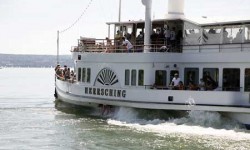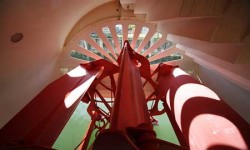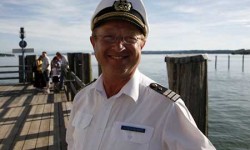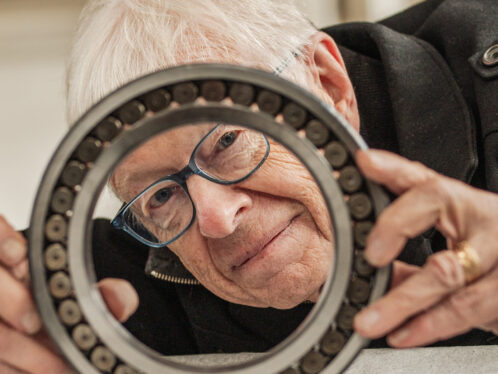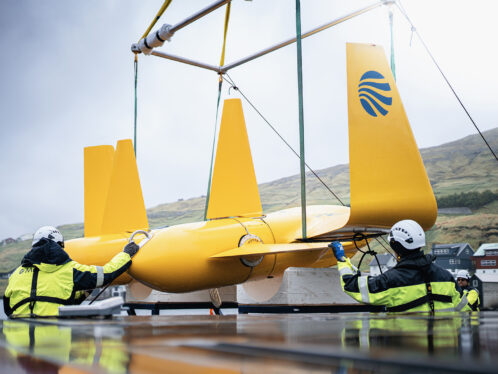
Big wheels in the water
The Lux-Werft shipyard in Mondorf, on the River Rhine, north of Bonn in Germany, has been building pleasure boats since just after World War II. But a contract to build the first post-war paddleboat in western Germany proved to be a special challenge.
The Lux-Werft shipyard in Mondorf, on the River Rhine, north of Bonn in Germany, has been building pleasure boats since just after World War II. But a contract to build the first post-war paddleboat in western Germany proved to be a special challenge.
It’s a sunny day on the Ammersee lake, south of Munich in southern Germany. Small clouds are moving gently across the sky, and there’s a light haze over the distant hills. The Herrsching is approaching the pier at Schondorf, and a little crowd of people is lined up, watching excitedly as the ship approaches.
Parents with children, elderly couples, cyclists on a touring holiday – they all watch as the big paddlewheels on the sides of the hull turn, splashing in the water, and the captain, Helmut Diller, maneuvers 177 feet of ship gently into place. A few passengers disembark, and the crowd boards in an orderly fashion.
And it’s off to Utting, where the woman whose job it is to push the gangplank on to the ship says, “We love the paddleboats, and the Herrsching is our favorite.”
The RMS Herrsching (RMS means Radmotorschiff or paddle-motor vessel) is one of five ships that the Bayerische Seenschifffahrt (Bavarian Lakes Shipping Line) operates on the Ammersee, and it’s one of two paddleboats. The other, the Diessen, was built in 1908, and it is still running, although it underwent a thorough rebuild in 2005–2006. But the Herrsching is new – delivered in 2001. Both ships are licensed for 400 passengers, but the Herrsching is 14 feet longer than its older sister, and at 46 feet wide, it’s about four feet wider.
Harald Lugmair, Ammersee shipping operations manager, says the Lux-Werft shipyard got the contract “because they were the only shipyard to make a serious offer to build a paddleboat.”
Josef Bremm of Lux-Werft, the ship’s designer, says he believes the Herrsching is the first such boat built in western Germany for around 70 years. “There were two paddleboats built in former East Germany, but they were built on modern principles and had paddles only because they had to work in shallow water,” he says.
For the Herrsching, Bremm had to research how such boats were built in the past. “I used as a model the Hohentwiel on Lake Konstanz,” he says. “My question was, how would a modern designer build a traditional paddleboat, using modern technology and materials?”
For one thing, the old boats were powered by steam. “In many ways, it’s a perfect combination, since the steam engine can drive the slow-turning paddlewheels without need for drastic down-gearing,” he explains. But steam engines are simply not efficient, and the designers had to turn to diesel. Diesel engines, however, provide more than 1,000 rpm, and that’s far too fast for the 50 rpm needed by the paddleboat. So the diesel engines power hydraulic motors that drive the paddlewheels. Speed is regulated by controlling the flow of oil in the hydraulic system, while the diesel motor runs at a constant speed.
Bremm says thatpaddlewheels are more efficient in shallow water than propellers. “I’m sure we would have more paddleboats if we had a better way of powering the low revolutions,” he says. Other shipping operators have shown an interest, but so far it hasn’t gone beyond that.
The construction of the paddlewheel is more complex than that of a propeller. A propeller is always in the water, while paddlewheels are repeatedly subject to the shock of hitting the surface. Bremm also improved the hydrodynamic design of the paddle blades, using experience from the aircraft industry. And he developed new pivots for the blades, using polymer bearings in rubber housings, to help counter the repeated shocks to which they are subject.
The paddleboat may have been innovative, but the Lux-Werft shipyard has been building ships for a long time. The Herrsching is No. 164 of, so far, 185 ships.
The Lux-Werft shipyard was founded in 1945 by Johann Lux, and the company is run by his son Hans-Peter Lux and Elmar Miebach, the eldest grandson of the founder. Miebach says that Lux was a trained shipbuilder who worked in an aluminum factory during the war. “Directly after the war was over, he branched out on his own, building small boats for the big Rhine barges,” Miebach recounts. “His first pleasure boats were built on a strawberry field, until he could afford to build a proper hall.”
Since 1956,the shipyard has also been operating its own pleasure boats on several lakes, and, says Joachim Münnich, from Lux-Werft’s technical division, “That means we can offer customers advice on how to run their operations. And they can occasionally try things out. In the early ’70s, old Mr Lux found that one of his ships was carrying more and more people, so he cut the ship in two and made it longer.”
Every ship is different. “We build according to the wishes of the client, but we bring our own experience to bear,” says Münnich. The company delivers to Germany and the surrounding countries, such as the Netherlands and Switzerland. Sometimes the boat is sailed all the way to its destination, along rivers and canals, even via the North Sea and the Baltic, but sometimes, as in the case of the Herrsching, it must be dismantled and transported over roadways.
Huge cranes lifted it onto a convoy of four low-loaders, the largest of which has 19 axles – each with eight wheels – and a powered vehicle at each end. The hull is as wide as two motorway lanes plus the emergency strip. When it traveled off the motorway, traffic lights and road signs had to be removed to let the monster through. At the other end, there were more cranes waiting to reassemble the ship and lift it into the lake.
But once in the water, the Herrsching moved gracefully and easily. Captain Diller can control it electronically or with an old-fashioned compass and steering wheel. “They are no longer required if you have radar and satellite navigation,” he says, “but they’re useful if the electronics break down. Sometimes I use one, sometimes the other.”
Since delivering the Herrsching, as well as delivering a smaller conventional ship, Lux-Werft has also been responsible for the complete refit and enlargement of the Diessen. That must now make Lux-Werft Germany’s premier paddleboat shipyard.
A tight solution
Developing a new design for a paddleboat like the Herrsching is a risky business, and it would be surprising if there were no surprises. During 2007, the operators had developed suspicions about one of the paddlewheels. The passengers were noticing strange noises and were even telling the operators that a bearing had gone.
At the end of the operating season, this paddle- wheel was dismounted and the bearings inside were found to be corroded. Water had seeped in, and there was scarcely any lubricant left in the bearings. Lux contacted SKF and SKF designer Hubert Kaiser recounts the incident. “You immediately wonder why this should happen, so we told them to dismount the other paddlewheel,” he says. “And the condition of the bearings mounted in this wheel was even worse.”
The seals were not working efficiently, and although there were pounds of lubricant in the housing, it wasn’t getting to the bearings. Kaiser thought up a solution. He redesigned the bearing arrangement within the given overall dimensions to include easy adjustment of the tapered rolling bearings, and incorporate improved and additional sealing as well as relubrication facilities to make sure fresh grease could reach the bearings. SKF delivered and installed the new bearing arrangement into the Lux housing. “We also advised Lux to add a protective nylon sealing labyrinth cap over the inside end of the assembly,” says Kaiser.
Lux-Werft’s Joachim Münnich says the challenge was the time pressure. The ships have to run from Easter to mid-October, and the shipyard only got the second set of damaged bearings in February. Only then could SKF and Lux start on the solution. “It was very tight,” says Münnich, and, exaggerating a little, he adds, “The bearings were still warm from the manufacturer when they arrived.” But the ship was ready for the 2008 season.


